Essential Oils for Pets: What Works and What to Avoid
In a hurry? Click here to read the Article Summary...
If you’ve fallen in love with essential oils for yourself and your family, you may have wondered if they can be safe and effective for your pets as well. The answer is yes – but only if administered in the right way and if you avoid certain essential oils that may be harmful to them. Here is an introduction on how to use essential oils for pets to enhance the health of your four-legged family members.
Essential Oils and Pets: 5 Key Considerations Before Using Essential Oils With Your Dog or Cat
Before we dive into what essential oils are considered safe for pets in specific situations, here are some overarching guidelines for using essential oils with your furry friends:
#1 – Remember that your pet is “wired for smell.”
According to research from Alabama A & M University and others, humans have about 5 million olfactory receptors in our nasal passages, which are microscopic proteins that allow us to detect odors. That sounds like a lot, but this number pales in comparison to how many your dog has.
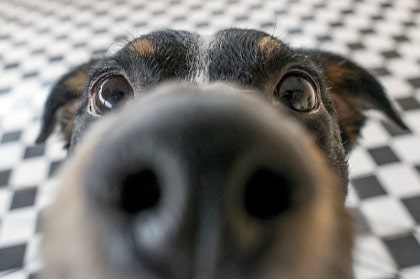
A dog has anywhere from 149 million to 300 million, which makes their sense of smell 10,000 to 100,00 times more acute than a human’s sense of smell.
To put it into perspective, while you might be able to detect a teaspoon of sugar in your cup of morning coffee (if you’re awake enough), Fido can detect that same amount of sugar in the equivalent of two Olympic-sized pools worth of coffee.
Your pooch’s sense of smell is very sensitive so take it slow when introducing a new essential oil.
The same guidelines apply with other domestic animals. Although dogs rule the roost when it comes to their sniffers, cats have up to 80 million receptors while rabbits have about 100 million. According to David Whitaker, PhD, of Middle Tennessee State University’s Horse Science Center, “Horses depend on their sense of smell the way we depend on language.”
If your main goal is to eventually use an oil topically or internally (only under vet guidance) with a pet, you may consider wearing a small amount of the essential oil yourself first and allowing your pet to get used to it by simply being around you.
Another method to gauge their reaction is to let your pet sniff the bottles with the covers firmly closed. Some experts even recommend letting your pet “choose” what oils they’re attracted to. Many different oils will usually work to accomplish the same goal. Therefore, you can set out 3 to 5 different appropriate oils on the floor (spread apart) and allow your pet to sniff the closed bottles and “select” the one they’re most interested in.
If you diffuse essential oils in your home, make sure your pet isn’t trapped in a room with the diffuser with no way to get away from the smell.
#2 – Keep your pet’s size in mind.
This may seem like common sense, but it’s worth stating. Remember that essential oils are powerful concentrations of plant essences. A little goes a long way – especially when used on animals and dilution is incredibly important.
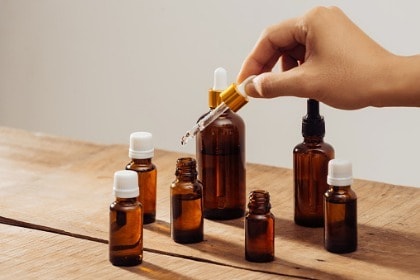
Essential oil particles (also called esters) are so small that they can be absorbed into the bloodstream with equal potency whether inhaled, ingested, or applied topically. Once in there, they work quickly on the body and brain.
Pet animals (usually) have much smaller bodies than humans, so proceed slowly and cautiously so you don’t overwhelm their senses. The smaller the animal, the more diluted an oil will need to be.
#3 – Keep it all-natural.
Don’t expose your four-legged family members to harmful chemicals that may do them more harm than good. These days you simply can’t assume that because an essential oil product says “all-natural,” that it’s chemical-free.
Read labels carefully. A truly natural essential oil will usually say “food grade,” “supplement grade,” or “100% organic” somewhere on the packaging. If you’re not sure, check out the company’s website or contact them directly.
If you’re still not convinced that the oil is of the highest quality and purity, it’s best not to use it. (Hint: If you purchased the essential oil at a grocery store, drug store, or gas station, chances are it isn’t the quality you should be using for health purposes.)
Fragrance oils and fragrances in products like air fresheners are harmful to your pet. Your precious pets can’t tell you they don’t like the products you’re using around them, so you need to pay attention to their needs and reactions.
#4 – Don’t use essential oils with pregnant, nursing, or baby animals.
Unless you’re working with someone qualified who can properly advise you, the safest bet is just to avoid using essential oils with any animal under 8-12 weeks as well as pregnant and lactating mothers.
- #5 – Cats are more sensitive than dogs to essential oils, so be extra cautious.
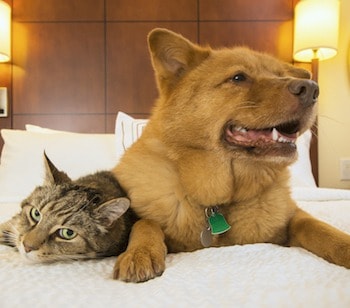
It’s difficult to make blanket statements about essential oils for “pets” because cats have some extra considerations even beyond those for dogs.
For example, many holistic vets recommend avoiding citrus oils and certain kinds of cedar essential oils with cats. Yet these oils are often included in DIY flea treatment recipes for dogs. “Warming oils” such as cinnamon are also usually NOT recommended for cats.
If you have both a cat and dog in your home you may need to limit what oils you use with your dog to accommodate your cat’s sensitivities.
Tea Tree Oil for Dogs & Other Pets: A Little is Beneficial. A Lot Can Be Deadly.
As mentioned above, a small amount of the right essential oil may be beneficial for your pet but too much may cause harm. This is especially the case with tea tree oil (also known as melaleuca).
While tea tree oil is safe for most adult humans, it can be downright lethal for pets if used undiluted.
A 2014 report published in the Journal of the American Veterinary Medical Association analyzed case studies obtained by U.S. Poison Control Centers over a 10-year period.
In close to 350 dogs and over 100 cats who were exposed to 100% (meaning undiluted) melaleuca essential oil, 77% developed toxicity-related reactions. Symptoms included weakness, lack of coordination, muscle tremors, drooling, depression, skin rashes, elevated enzyme levels in the liver and, in some cases, vomiting and coma. Smaller animals such as cats and kittens were most affected.
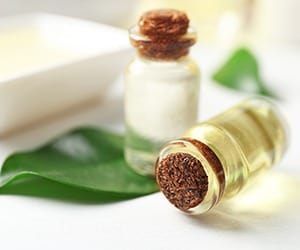
That being said, holistic vet experts such as Dr. Karen Becker, owner of Natural Pet Animal Care in Chicago, support that a VERY WEAK dilution of 0.1% to 1.0% strength* (diluted in water) of tea tree can be safely used on dogs to treat skin irritations or “hot spots,” wounds, infections, and even drug and environmental allergies. An important note that tea tree oil dilutions should be given to animals as a topical only, never orally.
*For reference, a 1.0% dilution is basically one (1) drop of essential oil in one (1) teaspoon of carrier oil or water. Therefore for a 0.1% dilution, you would use one (1) drop of essential oil to ten (10) teaspoons of carrier oil/water.
Using Safe Essential Oils Topically With Your Pets
Experts also state that for the topical use of safe essential oils for pets, very small animals like small dogs, cats, and rabbits can start out with 3 to 5 drops of DILUTED essential oil at a 0.25% dilution rate.
As an example of how to get a 0.25% dilution, you would mix 4 teaspoons of carrier oil and one (1) drop of essential oil together. You would then use a maximum of 3-5 drops of that diluted mixture with your pet. Again, this is ONLY with essential oils considered safe for pets.
If you’re unsure whether a dosage or a particular oil is safe for your pet, please connect with a local holistic veterinarian or qualified aromatherapist who can guide you. The American Holistic Veterinary Medical Association has a “Find a Vet” link on their website that can help you track down a holistic vet in your area.
Good Carrier Oils to Use With Pets
When you’re diluting essential oils there are many different oils that can be used. Some goods carrier oils to use with pets for topical application include:
- Avocado oil
- Virgin coconut oil (cold pressed) – fractionated is fine
- Extra virgin olive oil
- Jojoba oil
- Flaxseed oil
- Wheat germ oil
- Sesame oil
- Castor oil
Essential Oils for Pet Problems
Now that you know what to watch out for when it comes to your pets and essential oils, when might you consider using essential oils for pets? Below is a listing of some common pet health conditions that often benefit from essential oils.
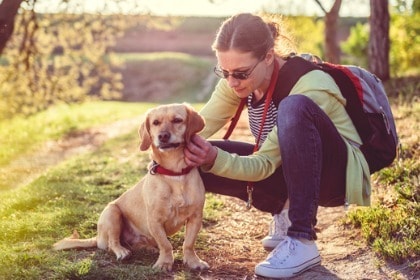
Ticks & Fleas
Ticks and fleas are probably the most widespread concern for spreading certain kinds of diseases and also for just being downright annoying for humans and pets alike. Many pet owners are also concerned with the toxicity levels of commercial flea & tick collars, topicals, and pills.
This concern is founded on a stark reality: many of the top flea- and tick-killing brands contain carcinogens and chemicals that can affect the nervous system.
You can make your own natural flea & tick repellents for your dog and cat using safe, high-quality essential oils for pets. Rosemary, lavender, and peppermint essential oils are popular in DIY recipes for dogs – both for their fresh small, as well as the ability to help to repel fleas.
There are a variety of recipes available online – just be sure you’re getting your information from a reputable site and using high-quality oils. Also, remember the tip above to pay special attention to oils used with cats.
Itchy skin
We already mentioned that small, very heavily diluted amounts of tea tree may do the trick with dogs, but there are other essential oils that can also calm hot spots. For example, small amounts of yarrow (especially from deep blue flowers), can help with these conditions. It can also stop bleeding for minor cuts and scrapes, such as trimming a nail too much into the quick, since it acts as an anti-inflammatory.
According to Janet Roark, DVM (aka “The Essential Oil Vet”), frankincense “helps soothe skin that is irritated, itchy or damaged, particularly when used in conjunction with lavender. It also relaxes and soothes sore muscles and joints in older animals.”
Nervousness
Ever had a cat that wouldn’t go into the cat cage no matter how much cajoling you did? Diffusing a little lavender essential oil may do the trick! Linalool and linalyl acetate are the terpenes (plant chemicals) in lavender that are most responsible for its calming effect on mammalian nervous systems.
Of course, cats are unique creatures and there are felines that absolutely detest lavender. If you have a lavender-hating cat, never try and force the issue.
For cats and dogs that seem amenable to it, you can use 100% organic lavender essential oil in a cold-mist diffuser in your home an hour or so before you’re ready to go or apply a tiny amount (again, heavily diluted in a carrier oil as stated above) on the back of the neck. Lavender is also great for dogs and cats who get jittery before traveling in general.
Confusion – For Dogs Only
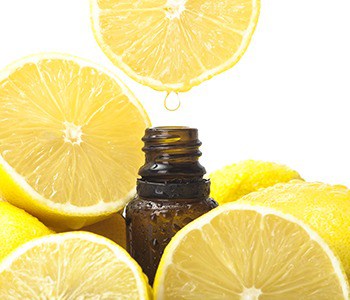
For dogs that have moved homes a lot, need to learn new information, or are getting a little confused, diffusing lemon essential oil is uplifting and clarifying. It is also reported to help increase trust in others, which can be helpful if you’re introducing a new family member.
Lemon oil is also an antiviral, antifungal, and antiseptic agent which makes it great for helping to clean the air in homes. Reminder: Lemon oil is a citrus oil and should not be given to cats topically or orally.
Immune System Support
Frankincense oil has been known to boost immune system function. Take caution when using frankincense on pets, however. A tiny amount of diluted oil is all that is needed. You may wish to increase your dilution rate and get the guidance of your vet before using this potent essential oil.
Essential Oils Bad for Pets: The Ones to Avoid!
The discussion continues between animal experts as to which herbs and essential oils to completely avoid with pets. The following generally make the essential oils bad for pets list (i.e., the ones to always avoid).
Once again, be sure to contact your veterinary health professional if you are ever unsure about whether or not an essential oil is safe to use with YOUR pet and ALWAYS ERR ON THE SIDE OF CAUTION.
- Bitter Almond
- Boldo
- Calamus
- Garlic
- Horseradish
- Mustard
- Pennyroyal
- Sassafras
- Wormseed (Chemopodium)
Essential Oils Generally Considered Safe to Use With Animals
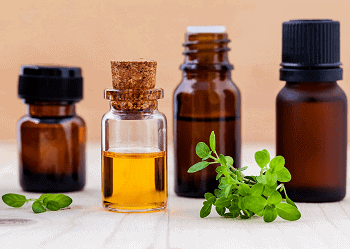
The following list contains oils considered safe for use with animals in general. This doesn’t mean these oils are safe for all animals, nor does it mean they’re all good for your individual pet.
Animals, like people, are unique and what works for one may not work for another. As mentioned above, always seek guidance from a professional if you’re ever unsure what you’re doing.
- Anise (Pimpinella anisum)
- Balsam Fir (Abies balsamea)
- Basil (Ocimum basilicum)
- Bay Laurel (Laurus nobilis)
- Bergamot (Citrus bergamia) – citrus; not for cats
- Black Cumin (Nigella sativa)
- Black Pepper (Piper nigrum)
- Blue Cypress (Callitris intratropica)
- Carrot Seed (Daucus carota)
- Cassia (Cinnomomum cassia)
- Catnip (Nepeta cataria)
- Cedarwood (Cedrus atlantica)
- Cilantro (Coriandrum sativum)
- Cinnamon Bark (Cinnamomum verum) – dilute heavily
- Cistus (Cistus ladaniferus)
- Citronella (Cymbopogon nardus) – citrus; not for cats
- Clary Sage (Salvia sclarea)
- Copaiba (Copaiba officinalis)
- Cypress (Cupressus sempervirens)
- Dill Weed (Anethum graveolens)
- Eucalyptus globulus
- Eucalyptus radiata
- Fennel (Foeniculum vulgare)
- Frankincense (Boswellia carterii)
- Geranium (Pelargonium graveolens)
- German Chamomile (Matricaria recutita)
- Ginger (Zingiber officinalis)
- Grapefruit (Citrus paradisi) – citrus; not for cats
- Helichrysum (Helichrysum italicum)
- Hyssop (Hyssopus officinalis)
- Idaho Tansy (Tanacetum vulgare)
- Juniper (Junniperus communis)
- Lavender (Lavandula angustifolia)
- Ledum (Ledum groenlandicum)
- Lemon (Citrus limon) – citrus; not for cats
- Lemongrass (Cymbopogon flexuosus)
- Lime (Citrus aurantifolia) – citrus; not for cats
- Marjoram (Origanum majorana)
- May Chang (Litsea cubeba)
- Melissa (Melissa officinalis)
- Myrrh (Commiphora myrrha)
- Myrtle (Myrtus communis)
- Niaouli (Melaleuca quinquenervia)
- Nutmeg (Myristica fragrans)
- Orange (Citrus sinensis) – citrus; not for cats
- Oregano (Oreganum vulgare) – dilute heavily
- Palmarosa (Cymbopogon martinii)
- Palo santo (Bursera graveolens)
- Patchouli (Pogostemon cablin)
- Peppermint (Mentha piperita)
- Roman Chamomile (Anthemis nobilis)
- Rose (Rosa damascena)
- Rosemary (Rosmarinus officinalis)
- Rosewood (Aniba rosaeodora)
- Rue (Ruta graveolens)
- Sandalwood (Santalum spicatum)
- Spearmint (Mentha spicata)
- Spikenard (Nardostachys jatamansi)
- Spruce (Picea mariana)
- Tangerine (Citrus tangerina) – citrus; not for cats
- Tarragon (Artemisia dracunclulus)
- Tea Tree (Melaleuca alternifolia) – note warning above
- Thyme (Thymus vulgaris) – dilute heavily
- Valerian (Valerian officinalis)
- Vetiver (Vetiveria zizanioides)
- Vitex (Chaste Tree, Vitex agnus castus)
- Western Red Cedar (Thuja plicata)
- White Cypress (Callitris glaucophylla)
- Ylang Ylang (Cananga odorata)
Closing Points to Consider When it Comes to Using Essential Oils With Pets
Just like the human body, the bodies of dogs, cats, and other pets contain innate healing mechanisms within. When given a chance, the body will naturally move towards balance and potential healing.
Using essential oils responsibly and conservatively can, in many cases, help bring an animal’s body back into balance without the potential side-effects of pharmaceutical drugs.
For people who are afraid of using essential oils with and around pets based on stories they’ve read on social media, rest assured that most toxicity or adverse events are the result of gross misuse and overdosage situations (i.e., full undiluted applications).
Melissa Shelton, DVM, and author of Animal Desk Reference: Essential Oils for Animals offered this advice in response to a viral Facebook post about a cat dying after being exposed to essential oils.
So often, essential oils are the obvious thing to blame when an animal all of a sudden appears ill. And the internet is an easy way to find support of this theory. However, in true clinical evaluation, I often find very poor cause and effect relationships. With the vast number of people using essential oils in their home, we can be quick to get into a trap of blaming any illness upon the presence of essential oils. And this, we need to be careful to avoid.
I have consulted with many veterinarians who missed the true diagnosis for weeks, due to the assumption that the essential oils were at the root cause. While I will never say essential oils cannot hurt an animal, we also need to be realistic that when a Facebook post is shared over half a million times, all to animal loving people – the statistics are in the favor of someone also having an animal that falls sick at the time of reading it.
https://londonalternativevet.com/2018/01/12/essential-oils-with-pets-dr-melissa-shelton/
The key takeaways when it comes to essential oils for pets are: quality matters, introduce slowly, dilute heavily, and seek guidance. If you follow these guidelines you’ll undoubtedly experience the amazing positive benefits of using essential oils with your precious pets.
The powerhouse trio of herbs in Magi-Complexx Essential Oil provides the strongest, most synergistic healing effect, helping sufferers of arthritis pain, constant muscle aches and pains, neuropathy, systemic inflammation, slowed wound healing, circulatory challenges, as well as skin irritations like eczema, psoriasis, and acne.
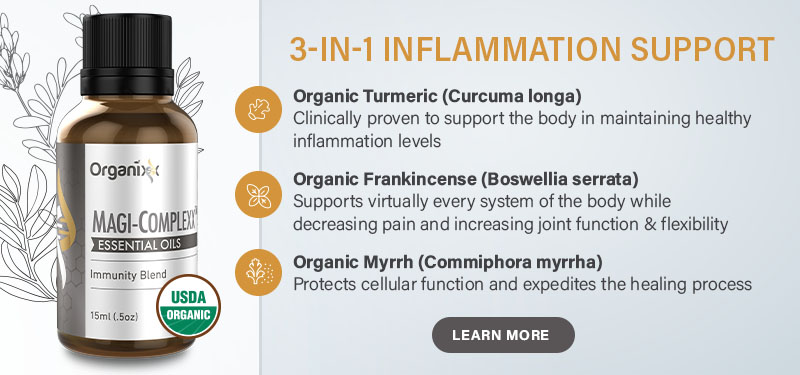
 Sources:
Sources:
Article Summary
Can essential oils be used safely with pets? Yes – but only if administered in the right way and if you avoid certain essential oils that may be harmful to them.
5 Key Considerations Before Using Essential Oils With Your Dog or Cat:
- Remember that your pet is “wired for smell.”
- Keep your pet’s size in mind.
- Keep it all-natural.
- Don’t use essential oils with pregnant, nursing, or baby animals.
- Cats are more sensitive than dogs to essential oils, so be extra cautious.
While tea tree oil is safe for most adult humans, it can be extremely toxic for pets if used undiluted.
Some health issues where essential oils can be used successfully (with guidance) include:
- Ticks & Fleas
- Itchy Skin
- Nervousness
- Confusion
- Immune System Support
The key takeaways when it comes to essential oils for pets are:
- Quality matters
- Introduce slowly
- Dilute heavily
- Seek guidance from a professional


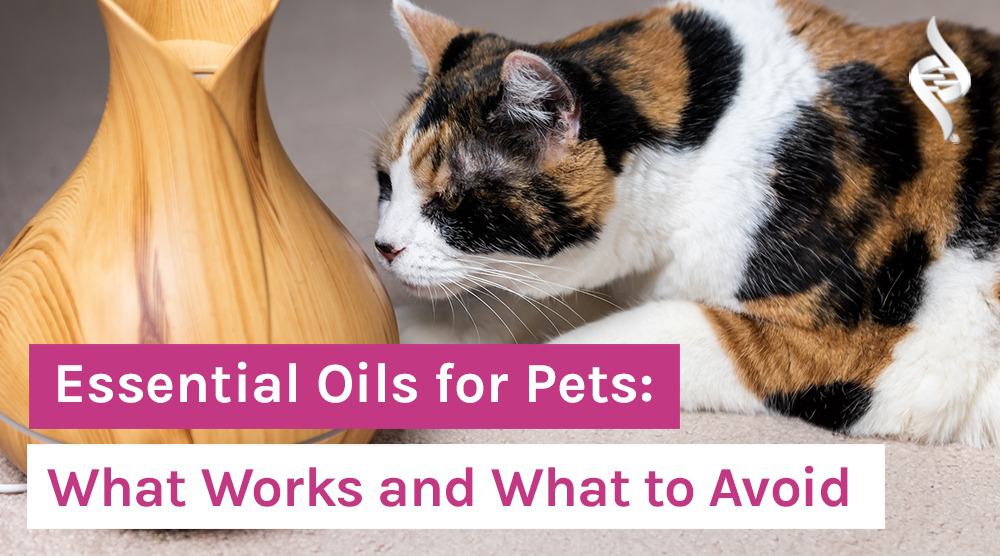
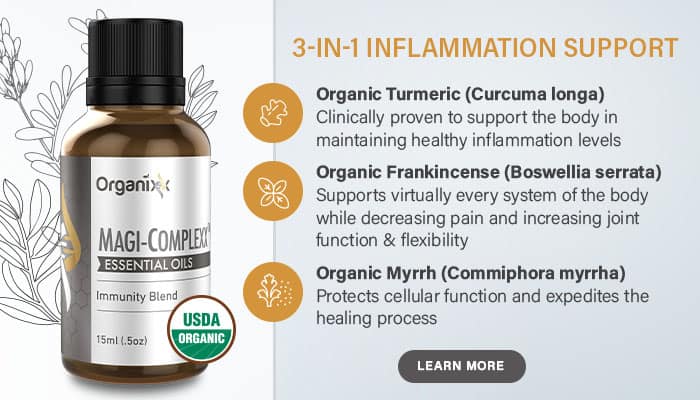

I found the article confusing. In one area it says that certain essential oils are toxic to pets in another area it says that the same oils can be used on pets. I am making a flea and tick spray.
Hi Laurel, we're sorry you found this article confusing. Thanks for your feedback.
Certain essential oils are considered safe with animals in general. This doesn’t mean these oils are safe for all animals, nor does it mean they’re all good for your individual pet. Animals, like people, are unique and what works for one may not work for another. We always recommend consulting with a professional if you're ever in doubt of what you're doing.
THE FOLLOWING ESSENTIAL OILS ARE GENERALLY CONSIDERED SAFE TO USE WITH ANIMALS:
- Anise (Pimpinella anisum)
- Balsam Fir (Abies balsamea)
- Basil (Ocimum basilicum)
- Bay Laurel (Laurus nobilis)
- Bergamot (Citrus bergamia) – citrus; not for cats
- Black Cumin (Nigella sativa)
- Black Pepper (Piper nigrum)
- Blue Cypress (Callitris intratropica)
- Carrot Seed (Daucus carota)
- Cassia (Cinnomomum cassia)
- Catnip (Nepeta cataria)
- Cedarwood (Cedrus atlantica)
- Cilantro (Coriandrum sativum)
- Cinnamon Bark (Cinnamomum Verum) – dilute heavily
- Cistus (Cistus ladaniferus)
- Citronella (Cymbopogon nardus) – citrus; not for cats
- Clary Sage (Salvia sclarea)
- Copaiba (Copaiba officinalis)
- Cypress (Cupressus sempervirens)
- Dill Weed (Anethum graveolens)
- Eucalyptus globulus
- Eucalyptus radiata
- Fennel (Foeniculum vulgare)
- Frankincense (Boswellia carterii)
- Geranium (Pelargonium graveolens)
- German Chamomile (Matricaria recutita)
- Ginger (Zingiber Officinalis)
- Grapefruit (Citrus paradisi) – citrus; not for cats
- Helichrysum (Helichrysum italicum)
- Hyssop (Hyssopus officinalis)
- Idaho Tansy (Tanacetum vulgare)
- Juniper (Junniperus communis)
- Lavender (Lavandula angustifolia)
- Ledum (Ledum groenlandicum)
- Lemon (Citrus limon) – citrus; not for cats
- Lemongrass (Cymbopogon flexuosus)
- Lime (Citrus aurantifolia) – citrus; not for cats
- Marjoram (Origanum majorana)
- May Chang (Litsea cubeba)
- Melissa (Melissa officinalis)
- Myrrh (Commiphora myrrha)
- Myrtle (Myrtus communis)
- Niaouli (Melaleuca quinquenervia)
- Nutmeg (Myristica fragrans)
- Orange (Citrus sinensis) – citrus; not for cats
- Oregano (Oreganum vulgare) – dilute heavily
- Palmarosa (Cymbopogon martinii)
- Palo santo (Bursera graveolens)
- Patchouli (Pogostemon cablin)
- Peppermint (Mentha piperita)
- Roman Chamomile (Anthemis nobilis)
- Rose (Rosa damascena)
- Rosemary (Rosmarinus officinalis)
- Rosewood (Aniba rosaeodora)
- Rue (Ruta graveolens)
- Sandalwood (Santalum spicatum)
- Spearmint (Mentha spicata)
- Spikenard (Nardostachys jatamansi)
- Spruce (Picea mariana)
- Tangerine (Citrus tangerina) – citrus; not for cats
- Tarragon (Artemisia dracunclulus)
- Tea Tree (Melaleuca alternifolia) – note warning above
- Thyme (Thymus vulgaris) – dilute heavily
- Valerian (Valerian officinalis)
- Vetiver (Vetiveria zizanioides)
- Vitex (Chaste Tree, Vitex agnus castus)
- Western Red Cedar (Thuja plicata)
- White Cypress (Callitris glaucophylla)
- Ylang Ylang (Cananga odorata)
THESE ESSENTIAL OILS ARE CONSIDERED BAD FOR PETS AND ARE ONES TO AVOID:
- Bitter Almond
- Boldo
- Calamus
- Garlic
- Horseradish
- Mustard
- Pennyroyal
- Sassafras
- Wormseed (Chemopodium)
For Fleas & Ticks... You can make your own natural flea & tick repellents for your dog and cat using safe, high-quality essential oils for pets.
Rosemary, lavender, and peppermint essential oils are popular in DIY recipes for dogs – both for their fresh smell, as well as the ability to help to repel fleas.
There are a variety of recipes available online – just be sure you’re getting your information from a reputable site and using high-quality oils.
Also, remember to pay special attention when using oils with cats as they are more sensitive than dogs.
We hope this helps clarify any confusion you encountered regarding the article. If there's anything else we can help you with, do let us know.
Thanks so much for being here with us. Hope you have yourself a wonderful day!
Can you give me some ideas for my 8 yr. old male cat who pulls his hair out and bites and scratches around the mammary glands(little bumps) on his stomach. I have tried everything but essential oil for the last 5+ years.
Thank you!
Hi Marty,
We're sorry to hear about your cat's current condition. Unfortunately, since Organixx cannot diagnose, treat or give advice regarding your pet's health, we highly recommend a consultation with a trusted veterinarian to help you determine if using essential oils would be beneficial for your pet's current health condition.
In addition, if you would like to learn more about the essential oils we carry in our product line, you may visit our online store here: https://shop.organixx.com/#essential-oils.
We appreciate you being here with us. Wishing you and your fur baby all the very best!!
If you have pets please do your own research instead of using this article. Dr. Robert Tisserand is the formost essential oil expert. He also refers most pet questions to specialized animal aromatherapists. If you love your cat please don't use essential oils on them and limit use around them. Cats lack the enzymes to break down the chemical constituents in essential oils. They should not be used on cats directly and should not be diffused (passively or mechanically) in an area the cat cannot easily leave. Diffusion should not be longer than 30 minutes and fresh air allowed into the area. Most of the listed "safe" oils are toxic to cats.
Be safe with oil sprays as well. Oil and water don't mix. If you want a safe room, body, etc spray, make the spray using 151+ proof grain alcohol to mix with the oil initially then add up to 2 parts water after the oil is completely dissolved in the alcohol. For example mix 1 tbsp 190 proof grain alcohol and 20 drops of oils. Let it sit until you no longer see an oil layer. Then add up to 2tbsp water and mix well. Anhydrous alcohol does not mix with water. If anhydrous alcohol is used, use enough alcohol to make the proper dilution.
3. The FDA does not regulate essential oils. An oil company can print anything on their label they want. The only way to know if an oil is pure is to review the gas chromatography mass spectrometry (GCMS) report for the lot number you are purchasing prior to purchase. If the company won't provide it, don't buy the oil. It either isn't tested or it isn't pure or the company is trying to hide something. Better to keep your family and animals safe. The most expensive oils are not necessarily the safest. Do your homework. Don't trust the salesperson.
No I don't work for the essential oil industry. Yes I use essential oils extensively. I am a scientist by trade and I have multiple chronic health conditions. I research anything I use since "safe" medications created part of my chronic health problems. Take control of your health. Do your own research. Check the credentials of those you listen to, look for conflicting information. Study up on physiology (and your pets as well if you want to keep them safe). Learn how the body works before you allow someone else to say something is safe for you or your family. Remember essential oils, supplements, and vitamins are not regulated at all in the US which is why they can't say they WILL have specific benefits on the labels.
Hi Rob, thank you for your comment. We appreciate the information, as well as the caution and warnings. We also agree that it is very important for users to do their research and check the credentials of the company and ask the opinion of a veterinarian when it comes to dealing with essential oils for pets.
Have a great day ahead!
There are a lot of great point here as to safe application of essential oils on and around pets. Frankincense is highly recommended for topical use on dogs that are prone to seizures. Some of the oils mentioned as generally safe may be triggers for seizures. This is not a complete list, but are oils mentioned as generally safe in the article: Eucalyptus, Fennel, Melaleuca, Rosemary, Spikenard, Blue Tansy, Thyme. Wintergreen should never be used on or around pets. Also, bird safety guidelines would be a great addition.
There is a great book available called "SpOil Your Pet", co-authored by Mia K Frezzo, DVM, and Jan C Jeremias, MSc.
Hi Juliana,
We certainly appreciate your feedback and the valuable information you shared.
Please know, the list of oils referenced in the article that are generally considered safe for animals, may not apply to every animal nor does it mean they're all good for your individual pet. If ever in doubt, we highly recommend consulting with a holistic veterinarian or qualified aromatherapist who can help guide you in the right direction when it comes to using essential oils on and around your pet.
Thank you for suggesting the bird safety guidelines as well as the book called "Spoil Your Pet". We would be more than happy to consider them as an addition to our future publications.
We appreciate you being part of the Organixx community & hope you have a lovely day!!
I was disgusted by the chemicals in flea/tick collars and treatments, so I make my own flea/tick spray.
I dilute the essential oils (lavender, peppermint, lemongrass, eucalyptus, thyme and a little cinnamon) into rubbing alcohol (not a carrier oil) in a spray bottle and spray down our cat and dog, and their bedding.
It has worked great!
Also, we have free-range chickens. One hen had a red and inflamed vent (poop end),
so I have her buttermilk with wheat germ to restore her microbiome
and sprayed her vent daily with almond oil with a few drops of tea tree oil.
She fully recovered and never infected the rest of the flock.
Marissa,
Can you tell me how many drops of each oil for the flea and tick formula and how much rubbing alcohol? Also, how many times did you apply this? And did you sprat their entire body?
Thank you!
Great work, Marisa! It seems like you really knows your essential oil for pets. Thank you for sharing your blends with us, they were all interesting and informative as well. We appreciate the tips and we wish you a wonderful weekend!